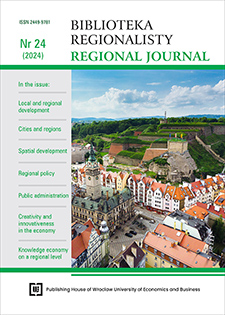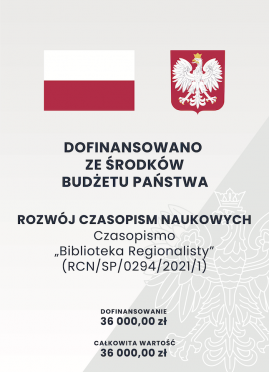Revitalization of a degraded area – Przystań Cesarska in Gdańsk
DOI:
https://doi.org/10.15611/br.2024.1.10Keywords:
revitalization, marina, Przystan Cesarska, Gdansk, sustainable developmentAbstract
Aim: The project to revitalize Przystań Cesarska (Emperor’s Harbour) in Gdańsk is aimed at identifying opportunities to transform a degraded port area into a modern, attractive place for residents and tourists.
Methodology: The research included analysis of literature, reports, documents and legal acts, field research, statistical data analysis, cartographic analysis, functional analysis of the case study, bench-marking and SWOT analysis. Key steps included site selection, data collection, field research and analysis of the marina environment. Examples of revitalized marinas, such as Marina Aker Brygge in Oslo, Marina Frapa in Rogoznica and OneOcean Port Vell in Barcelona, were used to establish critical success factors (CSFs).
Results: The results of the survey indicate that there is a low level of awareness of the existence of Emperor’s Harbour among residents and the poor condition of the infrastructure, which contributes to its low attractiveness. Most respondents rate the aesthetics of the marina as ‘neglected’, highlighting the need for major modernization work.
Implications and recommendations: Proposals include the renovation of infrastructure, the creation of new recreational areas, the clean-up of parking spaces and the increase of food and retail services. The project aims to create a multifunctional urban space that will contribute to the sustainable development of Gdansk.
Originality/value: The work is a valuable contribution to the discussion on the revitalization of port areas in historic cities, emphasizing the importance of aesthetics and functionality of public space to increase its attractiveness. The revitalization of Przystań Cesarska could become a model for other similar projects, emphasizing the importance of integrating various urban functions such as recrea-tional and leisure, tourism, cultural, social integration, and addressing the needs of both the local community and tourists.
Downloads
References
Aker Brygge Marina. (b.d.). https://www.akerbrygge.no/marina
Bilski, M. (2015). Selected human factors in marina design. Procedia Manufacturing, 3, 1646-1656. https://doi.org/10.1016/j.promfg.2015.07.482
Bryx, M. i Jadach-Sepioło, A. (2009). Rewitalizacja miast w Niemczech. Instytut Rozwoju Miast.
Grabski, M. (2014). Klimaty Nadodrza. Rewitalizacja wrocławskiego osiedla – ludzie, miejsca, wydarzenia. Urząd Miasta Wrocław.
Grindlay, A. L. i Martínez-Hornos, S. (2017). City–port relationships in Malaga, Spain: Effects of the new port proposals on urban traffic. WIT Transactions on The Built Environment, 176, 45-56. https://doi.org/10.2495/UT170051
Gyurkovich, M. (2019). Kamien Pomorski – health resort on the waterfront – transformations of the public space of the town after 1945’. IOP Conference Series: Materials Science and Engineering, 471(9), https://doi.org/10.1088/1757-899X/471/9/092008
Kamrava, M., Keshavarzian, A., Ramos, S., Salama, A. M., Gharib, R. Y., Tok, M. E. i Bontenbal, M. (2016). Gateways to the world: Port cities in the Persian Gulf. Oxford University Press. https://doi.org/10.1093/acprof:oso/9780190499372.001.0001
Kaźmierczak, R., Szczepańska, A., Grunwald, G., Kowalczyk, C. i Tanajewski D. (2022). Conceptual framework of a Global Yacht Positioning System in Poland. Applied Geomatics, 14, 79–91, https://doi.org/10.1007/s12518-021-00413-z
Lorens, P. (2009). Specyfika procesów przekształceń i rewitalizacji różnych typów obszarów zdegradowanych w miastach polskich. W: P. Lorens, J. Martyniuk-Pęczek (red.), Wybrane zagadnienia rewitalizacji miast (s. 24-31). Urbanista.
Lorens, P. (2010). Rewitalizacja miast – planowanie i realizacja. Wydawnictwo Politechniki Gdańskiej.
Marina Frapa Resort Rogoznica. (b.d.). https://www.marinafrapa.hr/en/rogoznica
Marina Port Vell. (b.d.). https://www.marinaportvell.com
Młode Miasto. Przyszłość dzielnicy – raport z procesu konsultacyjnego. (2021). https://s-trojmiasto.pl/download/2022/mlode-miasto-przyszlosc-dzielnicy-raport-z-procesu-konsultacyjnego.pdf
Nowaczyk, P. (2016). Determinanty rozwoju działalności żeglarskiej małych portów morskich w Polsce. Folia Pomeranae Universitatis Technologiae Stetinensis. Oeconomica, 82, 107-116. https://doi.org/10.21005/oe.2016.82.1.10
Oficjalny Portal Miasta Gdańska. (b.d.). https://www.gdansk.pl
Palacz, M. (2020). Gdańsk – Przystań Cesarska. https://marcinpalacz.pl/baltyk/gdansk-przystan-cesarska
Portal mapowy miasta Gdańska. (b.d.). https://ewid.gdansk.gda.pl/e-uslugi/portal-mapowy
Przystań Cesarska. (b.d.). https://przystancesarska.pl
Pudełko, A. (2016). Dziedzictwo kulturowe a rewitalizacja obszarów miejskich. W: Ł. Gaweł, W. Pokojska, A. Pudełko (red.), Ochrona i zarządzanie dziedzictwem kulturowym (s. 229-262). Wydawnictwo Attyka.
Rembarz, K. (2020). Możliwości wykorzystania infrastruktury portu jachtowego w procesie projektowania miejskiej prze-strzeni publicznej. Przestrzeń, Ekonomia, Społeczeństwo, 18(2), 49-72.
Stocznia Cesarska. (2018). Przystań Cesarska. https://stoczniacesarska.pl/pl/newstories/przystan-cesarska
Wu, Y. i Liu, Y. (2023). Transforming industrial waterfronts into inclusive landscapes: A project method and investigation of landscape as a medium for sustainable revitalization. Sustainability, 15(6), Article 5060. https://doi.org/10.3390/su15065060
Ziobrowski, Z. i Domański, B. (2010). Rewitalizacja miast polskich jako sposób zachowania dziedzictwa materialnego i ducho-wego oraz czynnik zrównoważonego rozwoju. Instytut Rozwoju Miast.
Downloads
Published
Issue
Section
License
Copyright (c) 2025 Aleksandra Kardynia, Dominika Szkop

This work is licensed under a Creative Commons Attribution-ShareAlike 4.0 International License.
Accepted 2024-12-15
Published 2025-01-31







